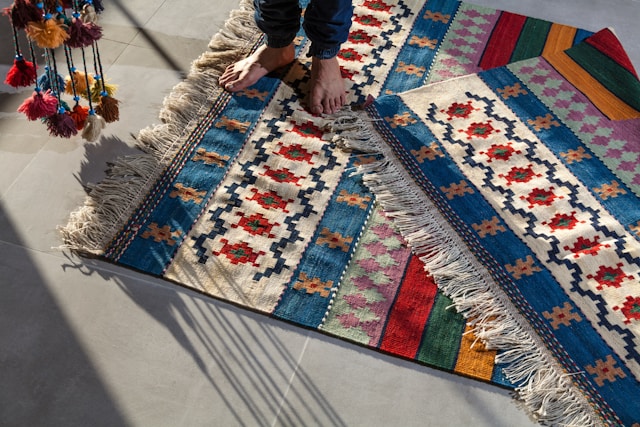Rugs are more than just cozy underfoot they’re foundational elements in any room’s design. The right rug can define a space, bring harmony to your furniture arrangement, and even make a room feel larger or more intimate. But choosing the correct rug size can be surprisingly tricky. Select one that’s too small, and the room may feel disconnected. Go too big, and it could overwhelm the space.
This comprehensive rug size guide will help you understand how to choose the right rug size for every room in your home whether you’re decorating your living room, bedroom, or dining area.
Why Rug Size Matters
Choosing the right rug size is about more than fitting a piece into a room. It’s about scale, proportion, and the way a rug visually anchors the furniture and space around it. A well-sized rug ties everything together and enhances the room’s flow and function.
A rug that’s too small can make furniture feel scattered and out of place. On the other hand, a rug that’s appropriately sized will ground the layout and add comfort, balance, and warmth to your design.
Standard Rug Sizes and Their Uses
Understanding common rug dimensions and their typical applications can help you make better choices. Here are some of the most frequently used sizes:
-
3′ x 5′ or 4′ x 6′: Great for small spaces, under coffee tables, or as accent rugs
-
5′ x 8′: Ideal for smaller living rooms, bedrooms, or under a coffee table with the front legs of furniture resting on it
-
8′ x 10′: A popular, versatile choice that works well in medium to large spaces
-
9′ x 12′: Great for large living rooms or bedrooms, allowing for more coverage under furniture
-
Runners (2′ x 8′, 2.5′ x 10′): Perfect for hallways, kitchens, or entryways
Keep in mind that actual needs can vary depending on the room’s dimensions and your furniture layout.
Rug Sizing by Room
Each room in your home has its own set of rug placement guidelines. Here’s how to choose the right rug size for each space:
Living Room
The living room is where rug size matters most. The goal is to create a cohesive seating area.
Best rug size for living room:
-
In small living rooms, a 5′ x 8′ rug can work well if placed under the coffee table with front legs of the sofa and chairs on the rug.
-
For a larger setup, an 8′ x 10′ or 9′ x 12′ rug should extend under all main furniture pieces, ideally allowing at least 6–10 inches of rug beyond the sofa sides.
Area rug placement tips:
-
Leave at least 12–18 inches of bare floor between the rug and the walls.
-
Avoid floating the rug in the middle of the room without anchoring it to any furniture.
Dining Room
Dining room rugs should be large enough to accommodate the table and chairs even when the chairs are pulled out.
What size rug for dining room?
-
Measure your dining table and add at least 24–30 inches on all sides. This allows chairs to move freely without catching the edge of the rug.
-
For a standard 6-person dining table, an 8′ x 10′ rug usually works well. For larger tables, consider a 9′ x 12′.
Bedroom
When choosing a rug for the bedroom, consider the bed size and how much floor coverage you want.
What size rug for queen bed or king bed?
-
Queen bed: An 8′ x 10′ rug will typically fit nicely under the bed, extending on both sides and at the foot.
-
King bed: Opt for a 9′ x 12′ rug to achieve balanced proportions.
Placement tips:
-
You can position the rug under the bottom two-thirds of the bed, leaving the nightstands off the rug.
-
Alternatively, use two runners on either side of the bed for a minimal, modern look.
Entryways, Hallways, and Kitchens
In these functional areas, rugs are mostly about defining the space and adding comfort underfoot.
-
Entryway: Choose a rug that fits the space without blocking door swings. A 3′ x 5′ or 4′ x 6′ rug often works well.
-
Hallways: Long runners (2′ x 8′ or longer) help guide the eye and add visual interest.
-
Kitchen: A small rug in front of the sink or a runner along a galley kitchen adds warmth and softness.
Tips for Measuring and Placement
To get the right fit, you need accurate measurements and smart placement. Here are some key tips:
-
Use painter’s tape to outline potential rug sizes on your floor before purchasing.
-
Aim for at least 6–8 inches of visible floor space around the rug.
-
Make sure the rug is centered under the main furniture grouping or focal point.
-
When placing under furniture, follow the “legs-on” rule: either all legs on the rug or at least the front legs.
Common Mistakes to Avoid
Even with a rug size guide in hand, it’s easy to make missteps. Here are a few to steer clear of:
-
Rug is too small: This is the most common mistake. Undersized rugs make rooms feel disjointed.
-
Ignoring furniture layout: Always think about how the rug interacts with your furniture, not just the room size.
-
Wrong shape: Sometimes a round rug is a better match than a rectangular one especially in small or curved spaces.
When in Doubt: Size Up
If you’re between rug sizes, go with the larger option. A big rug makes a space feel intentional, luxurious, and pulled together. A rug that’s too small can make even the most expensive room look unfinished. Larger rugs also improve comfort and sound absorption.
Final Thoughts
Choosing the right rug size is one of the most impactful design decisions you can make in a room. With the right measurements, a clear understanding of area rug placement tips, and a little planning, you can completely transform your space.

